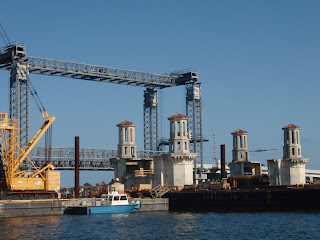

 The ICW is like a highway with many boats, most of them going south. There is very little opportunity to sail within the ICW as it is very narrow in most places. We have ended up motoring most of the time. Our maximum speed is 6 knots. If the current and the wind are with us, we can get up to 7 knots. We average about 5 knots an hour. Of course the power boats pass us going much much faster and we are bounced about in their wake. It seems that few have the common courtesy to slow down when passing sailboats.
The ICW is like a highway with many boats, most of them going south. There is very little opportunity to sail within the ICW as it is very narrow in most places. We have ended up motoring most of the time. Our maximum speed is 6 knots. If the current and the wind are with us, we can get up to 7 knots. We average about 5 knots an hour. Of course the power boats pass us going much much faster and we are bounced about in their wake. It seems that few have the common courtesy to slow down when passing sailboats.
One of the interesting parts of the ICW is the amount and variety of bridges that you must pass. Most bridges are 65 ft. in height which is plenty for us to pass under. However there are a variety of bridges that may have as little as 6 ft. vertical clearance. Most of these bridges have scheduled opening times usually on the hour although there are some that open on demand. Some have restricted times such as rush hours when they do not open to traffic at all. Some will not open if the winds are above a certain speed, usually 35 mph. Some can remain closed at the discretion of the bridge master in bad weather. Some of the railway bridges remain open unless a train is scheduled to pass.
 Bridges are constantly under repair. This is the
Bridges are constantly under repair. This is the Lions Bridge in St. Augustine Florida which is being rebuilt. This has been underway for two years and the completion date is 2009. This is not a quick process. A temporary bridge has been built to accomodate traffic over the bridge.
Lions Bridge in St. Augustine Florida which is being rebuilt. This has been underway for two years and the completion date is 2009. This is not a quick process. A temporary bridge has been built to accomodate traffic over the bridge.


Sometimes you pass under a bridge which you know is supposed to be 65 ft. high but as you go under it and look above, you are sure that you are going to shear the top of your mast off.

Here are some pictures showing how close the mast seems to be to the bridge. Often we hold our breath as we go under.

When the currents are strong it is quite tricky waiting for the bridge to open. Some boats have even dropped anchors if the wait is a long one and the conditions are difficult. We have found that we have become quite good at gauging the speed of our boat and the current to minimize the wait. Most bridges monitor VHF 09 throughout the ICW.
 Lift or Draw Bridge
Lift or Draw Bridge This one has a railway bridge in front of the draw bridge which is also raised.
Bascule Bridge

The bridge lifts up and down to let the boats through.
 Swing Bridge These are two different types but both are swing bridges.
Swing Bridge These are two different types but both are swing bridges.
Pontoon Bridge

The Sunset Beach Pontoon Bridge south of Cape Fear in North Carolina almost at the border of South Carolina is the last remaining pontoon bridge on the Atlantic ICW. Waiting boat traffic is usually heavy because it has zero clearance and opens only on the hour. Even the smallest of boats cannot pass through unless the span is open. When the bridge opens an entire section of the bridge which is on a pontoon moves out of the way. At periods of low tide it may be unable to open at all for several hours at a time. We were lucky with our timing and waited only about 20minutes.


No comments:
Post a Comment